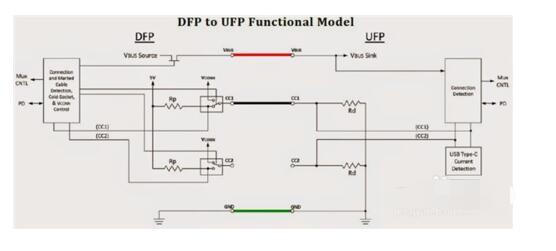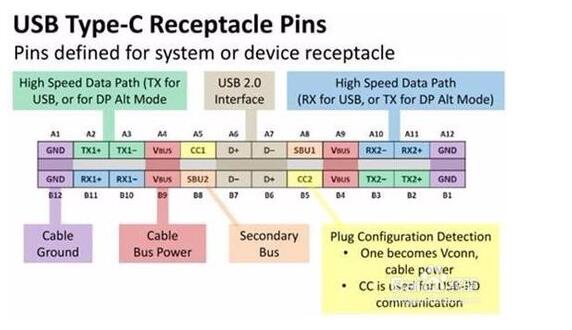At the 2015 CES show, Intel and the USB Implementer Forum showed the power of USB3.1 to the public. The specific interface is USBTypeC, which can be inserted in both positive and negative directions, and the size is similar to that of Micro-USB. In theory, the USB3.1TypeC can transmit at 10Gbps.
Parameters: size 8.3mm & TImes; 2.5mm speed 10Gbps
Typec interface pinThe following figure shows the interface pin diagram of type-c. Each pin has a different function. The center point is symmetrical so that it supports forward and reverse insertion.
TX/RX: two sets of differential signals for data transmission
CC1/CC2: Two key pins, a lot of functions
Probe connection to distinguish between DFP and UFP
Configure Vbus with USBtype-c and USBPowerDelivery modes
Configure Vconn. When there is a chip in the cable, a cc transmits a signal, and a cc becomes a power supply Vconn.
Configure other modes, audio accessories, etc.
GND and VBus, each 4, so the transmission power is strong
D+ and D- are standard before being compatible with USB.

DFP is the main, UFP is the slave, DRP can be the master or slave, depending on what is connected.
The CC pin of the DFP has a pull-up resistor Rp, and the UFP has a pull-down resistor Rd. When not connected, DFP's VBUS has no output.
When the CC terminal is connected, the CC pin of the DFP will detect the UFP pull-down resistor Rd, indicating that the DFP turns on the VBus switch to start power supply. Which CC pin (CC1, CC2) detects the pull-down resistor determines the direction of the interface insertion, and switches RX/TX by the way.

The two CCs actually have only one cc line in the cable without the chip. The cable containing the chip is not two cc lines, but a cc, a Vconn, used to power the chip in the cable (3.3V or 5V). At this time, there is no pull-down resistor Rd on the cc end, but Pull-down resistor Ra, 800-1200 ohms.
USB type-c has added new current detection and usage functions. Three new current modes are added: default USB power mode (500mA/900mA), 1.5A, 3.0A. Three current modes are transmitted and detected by CC pin. For DFPs that require broadcast current output capability, it is necessary to use different values ​​of CC pull-up resistor Rp. For UFP, it is necessary to detect the voltage value on the CC pin to obtain the current output capability of the other DFP.

Intelligent charging logo and fast charging: This 100 port USB charger automatically identifies the current signal and performs the current output according to the device restriction. The device is limited to intelligent and secure. Just plug in, no driver or software is required. The latest generation of USB hub controller, the maximum charging output of each USB port 3.5A. Single -port supports fast charging to save your time and energy. 100 % security charging: This 100 port USB charging station built -in smart chip is to prevent voltage from exceeding the current and overload. Reasonable cooling holes can effectively dissipate heat to prevent excessive excessiveness. Excessive charging protection, when these devices are fully charged, they will automatically convert to small charges flowing current, and the battery saturation rate is 99 %.

100 Port Usb Charger,100 Port Usb Wall Charger,Multi Port Usb Hub Charger,100 Port Usb Charging Station
shenzhen ns-idae technology co.,ltd , https://www.szbestchargers.com